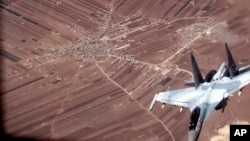The repeated harassment of U.S. drones by Russian fighter pilots in the skies over Syria is again drawing the ire of U.S. officials who now warn Russia’s antics are serving to help save key terror leaders from almost certain death.
U.S. military and defense officials have complained for months about increasing Russian harassment of U.S. drones and repeated incursions into the airspace over U.S. positions in Syria. But in the latest reported incident, the U.S. says Russian jets spent hours harassing two U.S. drones that were being used to track down and kill a senior Islamic State leader.
"It is almost as if the Russians are now on a mission to protect ISIS leaders," Pentagon deputy press secretary Sabrina Singh said Monday in response to a question from VOA.
"They know exactly where we operate and so there is no excuse for Russian forces’ continual harassment of our MQ-9s after years of U.S. operations in the area aimed at the enduring defeat of ISIS," Singh added, using an acronym for the Islamic State, also known as IS or Daesh.
U.S. Central Command announced Sunday the drones successfully tracked and killed Usamah al-Muhajir in eastern Syria on Friday, noting the same drones, earlier in the day “had been harassed by Russian aircraft in an encounter that had lasted almost two hours.”
Russia’s harassment of the drones used to kill al-Muhajir came a day after the U.S. accused Russian pilots of forcing U.S. drones to take evasive maneuvers in two separate incidents over a 24-hour period.
Those incidents, spanning this past Wednesday and Thursday, included what U.S. Central Command described as close flybys by Russian fighter jets that deployed flares and engaged their afterburners in an attempt to damage the drones’ electronic systems.
Singh declined to say Monday whether any of the incidents allowed other IS targets to escape, instead noting that at least on Friday the U.S. drones were able to successfully complete their mission.
Russia’s embassy in Washington has yet to respond to VOA requests for comment.
In June, the combined forces air component commander for U.S. Central Command accused Russian pilots in Syria of "buffoonery in the air.”
“Anytime you have an air force that has fallen so low on the professional ladder, that they're giving medals for buffoonery in the air, you've really got to wonder what they're thinking,” Lieutenant General Alexus Grynkewich told reporters at the time, adding Russia’s actions were allowing IS to rebuild.
“They are running training camps and they're building up their capabilities because the Russians and the [Syrian] regime are either incapable or unwilling to put pressure on ISIS,” he said. “They're letting the ISIS threat grow right under their nose."
The U.S. has about 900 troops in Syria to combat the threat from IS.
Intelligence estimates by United Nations member states shared in a report earlier this year indicate the terror group has about 2,500 to 3,500 fighters across Syria and Iraq.








